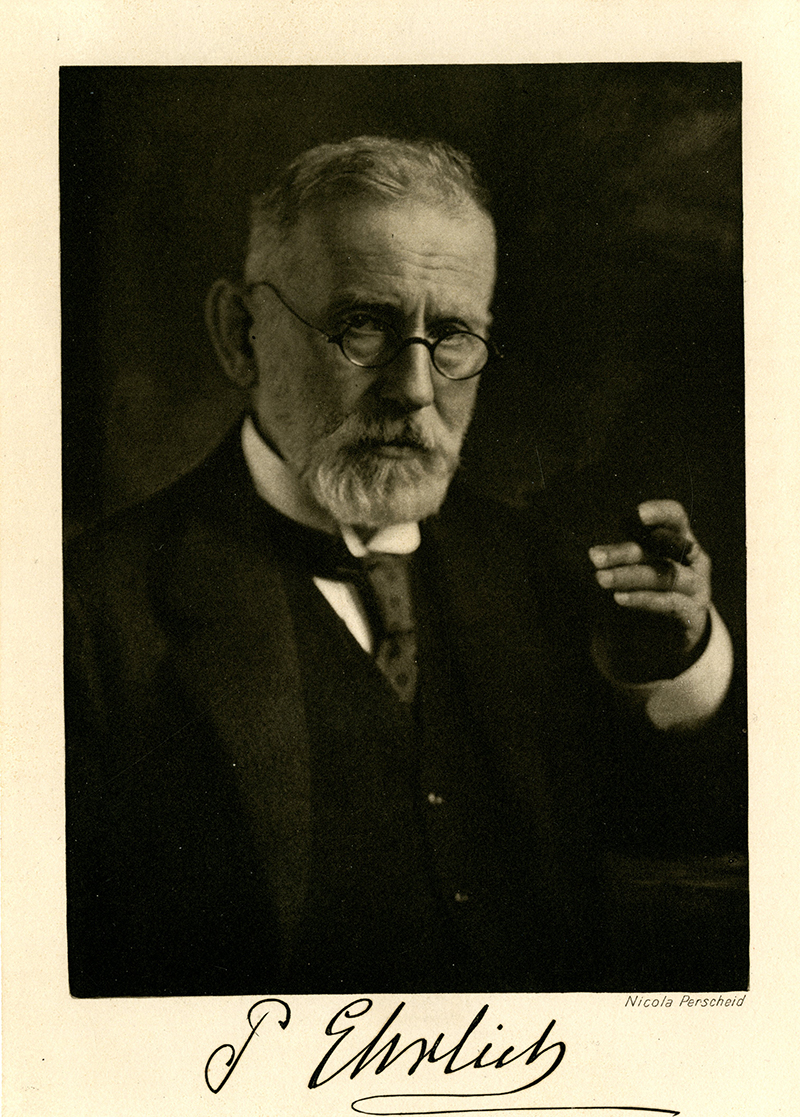Die experimentelle chemotherapie der spirillosen (syphilis, rückfallfieber, hühnerspirillose, frambösie), von Paul Ehrlich und S. Hata, mit Beiträgen von H.J. Nichols… J. Iversen… Bitter… Dreyer… Berlin: Julius Springer, 1910.
 Incorporating an interest in medicine, chemistry and histology, Paul Ehrlich became a pioneer of chemotherapy and a notable figure in the related studies of pathology, hematology and immunology. Along with Koch and Pasteur, he helped develop the science of bacteriology. As medical historian Logan Clendening explains in his Source Book of Medical History, “Hundreds of other men contributed details to the new science of bacteriology, but these three made it a completely integrated structure” (378). With even his earliest discovery, Ehrlich was already making significant contributions to that field. When his slides were accidentally placed on a hot stove during the bacilli staining process, he found that the application of heat greatly improves and quickens this staining procedure (Not. Med. Books 259). His hematology studies led him to the recognition that white blood cell counts can be used in diagnosis. He established methods for identifying leukemia and anemia, and is credited with the discovery of aplastic anemia.
Incorporating an interest in medicine, chemistry and histology, Paul Ehrlich became a pioneer of chemotherapy and a notable figure in the related studies of pathology, hematology and immunology. Along with Koch and Pasteur, he helped develop the science of bacteriology. As medical historian Logan Clendening explains in his Source Book of Medical History, “Hundreds of other men contributed details to the new science of bacteriology, but these three made it a completely integrated structure” (378). With even his earliest discovery, Ehrlich was already making significant contributions to that field. When his slides were accidentally placed on a hot stove during the bacilli staining process, he found that the application of heat greatly improves and quickens this staining procedure (Not. Med. Books 259). His hematology studies led him to the recognition that white blood cell counts can be used in diagnosis. He established methods for identifying leukemia and anemia, and is credited with the discovery of aplastic anemia.
n 1908, Ehrlich received a Nobel Prize with Elie Metschnikoff for his major immunological contribution, the development of the “side-chain” theory. Here, he proposed that specific chemical antibodies can be produced that will attack specific disease-causing bacteria while leaving the host body unharmed. The idea came to Ehrlich as a result of experiments he had performed using dyes as a student. He noticed that bacteria would take in the dye while tissue remained unaffected, and envisioned the possibility of similarly behaving drugs that could attach themselves to and fight bacteria while remaining unattached to the host body.
After receiving the Nobel Prize for this theory, the next step for Ehrlich was to begin looking for substances that would behave in this manner, and he began chemically altering germicides and disinfectants so they would not affix to the host (Cambridge 264). He was hoping to find a “magic bullet” antibody. Along with his assistant, Sahachiro Hata, Ehrlich performed experiments on 605 chemical compounds before finding Ehrlich’s 606 “magic bullet”. Salvarsan, as it was later named, proved successful in fighting syphilis, and this discovery spurred on the further development of chemotherapy (Heirs of Hippocrates 1117). The Reynolds-Finley Library has a copy of the 1910 publication by Ehrlich and Hata which reveals their findings, Die experimentelle chemotherapie der spirillosen (syphilis, rückfallfieber, hühnerspirillose, frambösie). Included in this book are Ehrlich’s essay on the chemotherapy of syphilis and Hata’s reports on their experiments with Salvarsan (One Hund. Books 92). Ehrlich was re-nominated for a Nobel Prize for his contributions to chemotherapy in 1912 & 1913, but only won in 1908.
Cambridge. Illus. Hist. Med., p. 264; Clendening, Source Book of Med. Hist., p. 378; Heirs of Hippocrates, 1117; Not. Med. Books, p. 259; One Hund. Books, 92; Reynolds Historical Library, Rare books and coll., 1346.
Image: Paul Ehrlich, [From] Apolant, H. Paul Ehrlich Eine Darstellung seines wissenschaftlichen Wirkens (1914), Reynolds-Finley Historical Library.
